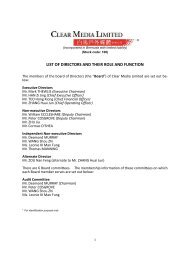Annual Report 2003 - Clear Media
Annual Report 2003 - Clear Media
Annual Report 2003 - Clear Media
Create successful ePaper yourself
Turn your PDF publications into a flip-book with our unique Google optimized e-Paper software.
NOTES TO FINANCIAL STATEMENTS<br />
31 December <strong>2003</strong><br />
3. Summary of Significant Accounting Policies<br />
(continued)<br />
Joint venture companies<br />
A joint venture is a company set up by contractual arrangement, whereby the Group and other parties undertake an<br />
economic activity. The joint venture company operates as a separate entity in which the Group and the other parties<br />
have an interest.<br />
The joint venture agreement between the venturers stipulates the capital contributions of the joint venture parties,<br />
the duration of the joint venture and the basis on which the assets are to be realised upon its dissolution. The profits<br />
and losses from the joint venture company’s operations and any distributions of surplus assets are shared by the<br />
venturers, either in proportion to their respective capital contributions, or in accordance with the terms of the joint<br />
venture agreement.<br />
A joint venture company is treated as:<br />
(a) a subsidiary, if the Company has unilateral control, directly or indirectly, over the joint venture company;<br />
(b) a jointly-controlled entity, if the Company does not have unilateral control, but has joint control, directly or<br />
indirectly, over the joint venture company;<br />
(c) an associate, if the Company does not have unilateral or joint control, but holds, directly or indirectly, generally<br />
not less than 20% of the joint venture company’s registered capital and is in a position to exercise significant<br />
influence over the joint venture company; or<br />
(d) a long term investment, if the Company holds, directly or indirectly, less than 20% of the joint venture company’s<br />
registered capital and has neither joint control of, nor is in a position to exercise significant influence over, the<br />
joint venture company.<br />
Related parties<br />
Parties are considered to be related if one party has the ability, directly or indirectly, to control the other party, or<br />
exercise significant influence over the other party in making financial and operating decisions. Parties are also<br />
considered to be related if they are subject to common control or common significant influence. Related parties<br />
may be individuals or corporate entities.<br />
Impairment of assets<br />
An assessment is made at each balance sheet date of whether there is any indication of impairment of any asset, or<br />
whether there is any indication that an impairment loss previously recognised for an asset in prior years may no<br />
longer exist or may have decreased. If any such indication exists, the asset’s recoverable amount is estimated. An<br />
asset’s recoverable amount is calculated as the higher of the asset’s value in use or its net selling price.<br />
An impairment of loss is recognised only if the carrying amount of an asset exceeds its recoverable amount. An<br />
impairment loss is charged to the profit and loss account in the period in which it arises, unless the asset is carried<br />
at a revalued amount, when the impairment loss is accounted for in accordance with the relevant accounting policy<br />
for the revalued asset.<br />
THE AGE OF<br />
CONSUMERS<br />
67






